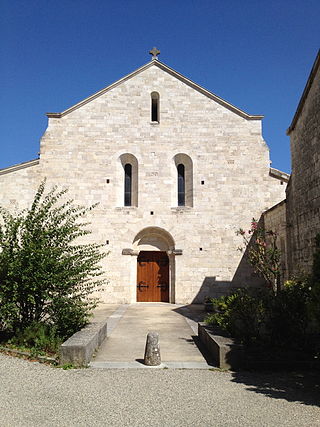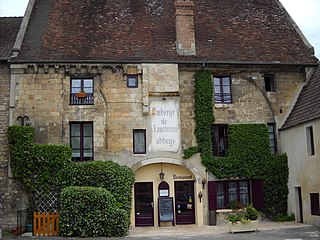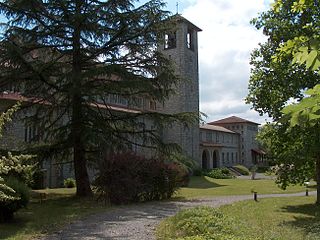
Valognes Abbey (French : Abbaye Notre-Dame de Protection de Valognes) is a 17th-century Benedictine abbey located in Valognes, France.

Valognes Abbey (French : Abbaye Notre-Dame de Protection de Valognes) is a 17th-century Benedictine abbey located in Valognes, France.
In 1623, Jean de Raval, Lord Tourlaville, and his wife Madeleine de la Vigne offered de la Vigne's cousin enough money to establish a monastery on the proviso that de la Vigne's would become the first abbess or "superior". The following year, the Bishop of Séez gave permission for a group of nuns to join the new abbey.
Plague prevented the nuns from taking up their new posts and construction did not begin until 1631. Later that year, enough construction had been completed so as to offer the nuns basic shelter and some took up residence. Finally King Louis XIII awarded a charter to Charlotte de la Vigne but she was not officially appointed until 1647. Construction was finally completed in October of that year.
Like other abbeys of France, Valognes suffered during the French Revolution and the persecution of religious orders.
During World War II, the abbey and its surroundings were heavily bombed. In a single fortnight in June 1944, 84 bombs fell in the monastery. The nuns returned to a heavily damaged abbey. In 1953, a nun who had taken refuge in the abbey during World War I returned, was elected superior and led efforts to rebuild the monastery.
Though the abbey remains active, with resident nuns, most of the buildings have now been converted into the modern Hôpital de Valognes.

The Abbey of Notre-Dame des Neiges or Our Lady of the Snows is a Cistercian monastery in the Ardèche département of south-central France. The former Trappist monastery has been resettled by Cistercian nuns in 2022. The abbey was built in 1850, located on the territory of the commune of Saint-Laurent-les-Bains, about one and a half miles east of the village of La Bastide-Puylaurent (Lozère).

Aiguebelle Abbey is a Trappist monastery situated in the communes of Montjoyer and Réauville in the département of Drôme, on the borders of the Dauphiné and of Provence, France.
Faremoutiers Abbey was an important Merovingian Benedictine nunnery in the present Seine-et-Marne department of France. It formed an important link between the Merovingian Frankish Empire and the southern Anglo-Saxon kingdoms of Kent and East Anglia.

Le Bec-Hellouin is a commune in the department of Eure in the Normandy region in northern France.

The Trappist Abbey of Rochefort or Abbey of Notre-Dame de Saint-Rémy, which belongs to the Cistercians of Strict Observance, is located in Rochefort in the province of Namur. The abbey is famous for its spiritual life and its brewery, which is one of few Trappist beer breweries in the world. Life in the abbey is characterised by prayer, reading and manual work, the three basic elements of Trappist life. The motto of the abbey is Curvata Resurgo.

Scourmont Abbey is a Trappist monastery on the Scourmont plateau, in the village of Forges which is part of Chimay in the province of Hainaut, Belgium. The abbey is famous for its spiritual life and for running the Chimay Brewery, one of the few producers of Trappist beer.

Chimay Abbey is an abbey in Wallonia in the city of Chimay, Hainaut, Belgium.

Soleilmont Abbey is an abbey of Trappistine nuns situated in the forest and commune of Fleurus, at Gilly near Charleroi, Belgium, founded, according to tradition, in the 11th century, which became Cistercian in 1237. The nuns were expelled as a consequence of the French Revolution in 1796, but soon re-established themselves in 1802. The community became Bernardine in 1837, and Trappist in 1919.

Igny Abbey or Val d'Igny Abbey is a Cistercian abbey located in Arcis-le-Ponsart, Marne, France. It was founded in 1128 for Cistercian monks, dissolved in 1791 during the French Revolution, re-established in 1876 for Trappist monks, destroyed in 1918, reopened in 1929 for Trappist nuns and modernised in 2008–12 to accommodate three or four pre-existing communities.

Argentan Abbey otherwise Notre-Dame de la Place is an 11th-century Benedictine abbey in Argentan, France. It is now a restaurant.

Tournay Abbey is an active Benedictine monastery in Tournay, Hautes-Pyrénées, France.

Maredret Abbey, also known as l’Abbaye des saints Jean et Scolastique, is a monastery of Benedictine nuns located on the edge of Maredret, a very small village in the hilly countryside to the south of Charleroi and Namur, Wallonia, Belgium. The abbey was inaugurated with the installation of seven nuns in 1893, and the abbey church was constructed between 1898 and 1907.

The Abbey of Notre Dame aux Nonnains, also called the Royal Abbey of Our Lady of Troyes, was a convent founded before the 7th century in Troyes, France. The non-cloistered canonesses became wealthy and powerful in the Middle Ages. In 1266–68 they defied the pope and used force to delay construction of the collegiate Church of St Urbain. They were excommunicated as a result. Later the abbey adopted a strictly cloistered rule and the nuns became impoverished. Work started on building a new convent in 1778 but was only partially completed before the French Revolution (1789–99). The abbey was closed in 1792 and the church was demolished. The convent became the seat of the prefecture of Aube.
The Abbey of St. John, Laon was a Benedictine monastery in Laon, France, from 1128 to 1766, which replaced a nunnery founded in 641. The prefecture of the department of Aisne now occupies the site.

Fontenelles Abbey or Les Fontenelles Abbey was an Augustinian monastery in the former commune of Saint-André-d'Ornay, in the Vendée, France.
49°30′13″N1°27′48″W / 49.5035°N 1.4634°W